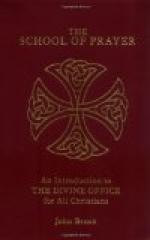But it was felt by scholars that Quignonez’s reforms were too drastic. Tradition was ignored. The labour for brevity, simplicity and uniformity led to the removal from this Breviary of antiphons, responses, little chapters and versicles, and to the reduction of lessons at matins to three, and the number of psalms in each hour was usually only three. His work had as a set principle the grand old liturgical idea of the weekly recitation of the whole psalter. The quick and almost universal demand for Quignonez’s Breviary indicated the need of a reform and the outline of such a reform. The Pope, who commissioned Quignonez to take up breviary reform, requested the Theatines to take up similar work. The Council of Trent (1545-1563) took up the work of reform. But the Council rose before the work had made headway, and the matter of reform was finally effected by St. Pius V. (1566-1572), by his Constitution, Quod a nobis (1568).
The Reformed Breviary of 1568 is, in outline, the Breviary in our hands to-day. The great idea in the reform was to restore the weekly recitation of the whole psalter. Theoretically, the Breviary made such provision, but practically the great number of saints’ offices introduced into the Breviary made the weekly recitation of the psalter an impossibility. The clergy were constantly reading only a few psalms out of the 150 in the psalter. The rubrics, too, were in a confused state. Changes were made in the calendar by suppression of feasts, by restoring to simple feasts the ferial office psalms, and by reducing the number of double and semi-double feasts. But in the body of the Breviary the changes were few and slight. The lives of some saints drawn from Quignonez’s work were used, St. Gregory’s canon of scripture lessons was adopted and the antiphons, verses, responses, collects and prayers were taken from the old Roman liturgy. The antiphons and responses were given in the older translation of St. Jerome owing to their suitability for musical settings. And the text of the psalms was the Psalterium Gallicanum, which had been in use in the Roman Curial Breviary,




